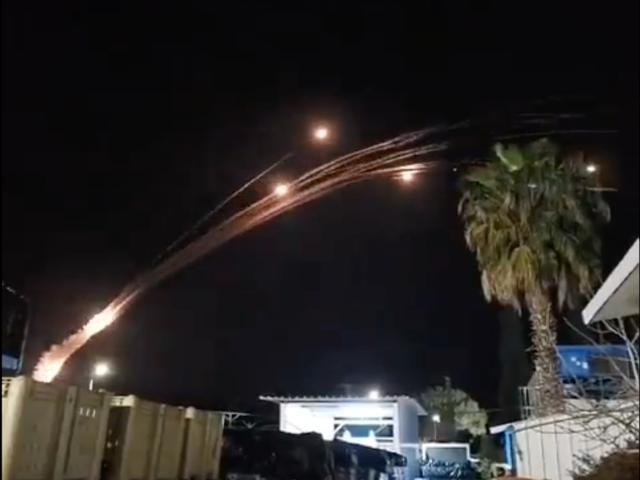Israel and Hezbollah, an ally of Hamas, have been engaging in almost daily exchanges of fire since the Lebanese terror group began indiscriminately firing rockets at Israel in support of the October 7 attack by the Palestinian Islamist terror group Hamas on southern Israel, igniting a conflict that has now prolonged into its eighth month. This recent escalation reflects the enduring tension that has forced over a hundred thousand Israelis living on the border with Lebanon to become displaced.
On Thursday, Hezbollah intensified the conflict by firing over 60 Katyusha rockets at several Israeli areas of the Golan Heights, including civilian homes and infrastructure. Hezbollah's statement declared these strikes were retaliatory, responding to Israeli bombardments the previous night in Lebanon's Bekaa region, particularly around Baalbek, a stronghold for the group. The truth, however is that Hezbollah began firing on October 8th which set off a tit-for-tat skirmish where Israel targets the launch sites of the missiles being fired on the country.
Hezbollah is taking a beating at the moment. Israel is fighting for its survival. Pray for Israel, pray for the IDF. pic.twitter.com/yWb98MmTZx
— Jewish Lumber King 🇺🇲🌳🇮🇱 (@EzraDrissman) May 15, 2024
The context of these skirmishes traces back to earlier provocations. Just before the rocket attack, Lebanese state media reported an Israeli air raid in the Baalbek area. This area, deeply influenced by Hezbollah and bordering Syria, experienced significant damage; local reports indicated minor injuries to a civilian and several fires. A source linked to Hezbollah mentioned that one Israeli strike targeted a military camp associated with the group.
An Israeli army spokesman confirmed the airstrike, stating it was aimed at a site crucial to Hezbollah's precision missile project, marking a continued focus on undermining Hezbollah's military capabilities. Earlier this week, a Hezbollah barrage targeted the Northern Israeli city of Kiryat Shmona, damaging dozens of buildings and setting the countryside on fire. An Israeli soldier was also killed the following day and several injured in another attack by Yiftach, in the Golan Heights.
Massive missile direct hit in Kiryat Shmona, north Israel, this morning
— Hamas Atrocities (@HamasAtrocities) March 27, 2024
Mind you, there is no territorial dispute between Israel and Lebanon.
This is Hezbollah firing rockets against civilian targets in Israel pic.twitter.com/GkMprleuzI
Hezbollah's aggression included a drone attack that struck popular junction called Tzomet Golani, just outside Tiberias, marking one of its deepest incursions into Israeli territory since the conflict escalated on October 8. Tzomet Golani, named for a famous Israeli army battalion is a large are where two highways intersect and contains a highly frequented rest-stop with restaurants, gas stations and camping supply stores. This operation followed an incident where Israel eliminated a top Hezbollah field commander in southern Lebanon, with the group later acknowledging the loss of Hussein Makki in Israeli attacks.
The ongoing clashes have had devastating effects on both sides of the border. According to AFP, the violence has resulted in the deaths of at least 413 people in Lebanon, predominantly Hezbollah commanders and militants in targeted strikes, but also several civilians that Israel has acknowledged were unintentional. On the Israeli side, the conflict has claimed the lives of 10 civilians and 14 soldiers, injuring hundreds of civilians and causing considerable damage to homes, apartment buildings and public works infrastructure. The hostilities have also forced tens of thousands from their homes, creating a significant displacement crisis in the region, however it was Israel's evacuation of many areas early on that has helped keep the casualty count low.
Approximately 40 rockets were launched by Hezbollah towards Israel in the last hour alone. This is insanity.
— Vivid.🇮🇱 (@VividProwess) May 15, 2024
where are the “ceasefire now” people? Silent all of a sudden?
You can actually hear children crying in fear in the Druze village of Beit Jan💔
pic.twitter.com/iWpVKNW41b
These recent events are part of a broader history of hostilities between Israel and Hezbollah, including significant conflicts in 2006 (Second Lebanon War) and numerous smaller clashes. Hezbollah's continued attacks on Israel can be seen as part of its broader strategy to challenge Israeli actions in the region, often in coordination with Iran and Syria, and to assert its role as a key player in the Lebanese political and military landscape.


